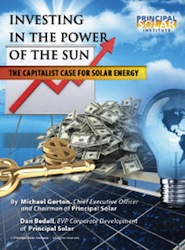Solar power is expected to reach grid parity when solar panels can be produced for under $0.70/watt with a total system cost under $2.00. As solar PV costs have been trending downward, grid parity could be reached as early as 2013 if the trend continues. This is according to a new free white paper, “Investing in the Power of the Sun: The Capitalist Case for Solar Energy,” authored by Michael Gorton, chief executive officer and chairman of Principal Solar along with Dan Bedell, executive vice president of corporate development of Principal Solar.
 In addition, the white paper states, “Solar PV has experienced exponential cost drops year-after-year for over 30 years, with projections putting PV module costs at $.50/watt, total system costs under $2.00 per watt and output electricity at just under 6 cents per kWh – grid parity in 2014.”
In addition, the white paper states, “Solar PV has experienced exponential cost drops year-after-year for over 30 years, with projections putting PV module costs at $.50/watt, total system costs under $2.00 per watt and output electricity at just under 6 cents per kWh – grid parity in 2014.”
Today, China is leading the way on solar PV production and pricing. I had the opportunity to correspond with Dan Bedell and the first question I asked was if U.S. solar panel manufacturers can also reach grid parity or will we see China reach this first and the U.S. to follow?
“The U.S. will likely continue to trail China and other lower cost manufacturing countries in the race to the cheapest-priced solar module,” said Bedell. “However, the U.S. supplies a large percentage of the silicon that China uses to manufacture modules and the modules we import are then installed by Americans. It’s only the assembly process in the middle that is currently occurring primarily overseas. To focus too much on the location of the manufacturing, obscures the true financial impact and the huge benefit on the U.S. economy of dropping solar prices.”
With concern over the loss of government support of solar power and other renewables I asked Bedel what would happen if the U.S. can’t reach grid parity by 2013. Will it put the industry is greater jeopardy?
He responded, “Grid parity is not a question of if, only when. Solar modules will continue to decrease in price: silicon is cheap and abundant and modules have been manufactured on a large scale for less than ten years. Grid parity is a wave, not a static point in time so more and more locations will find themselves at grid parity as solar pricing continues to decrease and electricity pricing continues to increase.”
While this is positive news, I asked Bedell if there are a dichotomy of events that could cause the loss of the U.S. solar manufacturing industry. “There are a lot of factors that could cause the continuing decrease of American module manufacturing, but it’s important to note that the module manufacturing process is only a small piece of the financial pie that is solar photovoltaic  electricity production. All modules have to be installed locally and they necessarily produce electricity locally. It’s interesting to note that as modules become more commoditized and prices continue to decrease, shipping becomes a larger percentage of the total cost. At some point, it’s likely that domestic manufacturing becomes a cost advantage.”
electricity production. All modules have to be installed locally and they necessarily produce electricity locally. It’s interesting to note that as modules become more commoditized and prices continue to decrease, shipping becomes a larger percentage of the total cost. At some point, it’s likely that domestic manufacturing becomes a cost advantage.”
On the flip side, I asked Bedell if there were a dichotomy of events that would enable the U.S. solar manufacturing industry not only to compete, but potentially overtake China, the country’s biggest competitor.
“If the technology required to produce modules continues to improve and module pricing continues to drop at this precipitous rate, it will become cheaper to utilize domestically-sourced silicon to manufacture modules in the U.S. and avoid the shipping costs inherent in sending raw silicon to China and bringing completed modules back to the U.S.,” responded Bedell.
There are other interesting insights in Investing in the Power of the Sun. For example, the authors lay out the case for nuclear and forecast that it will remain a substantial part of America’s energy mix. In addition, the report says there is a great opportunity to pair solar systems with natural gas to provide consumers with energy.
In the end, as Bedell demonstrated, there is a strong capital case for the development of solar power in the U.S.

